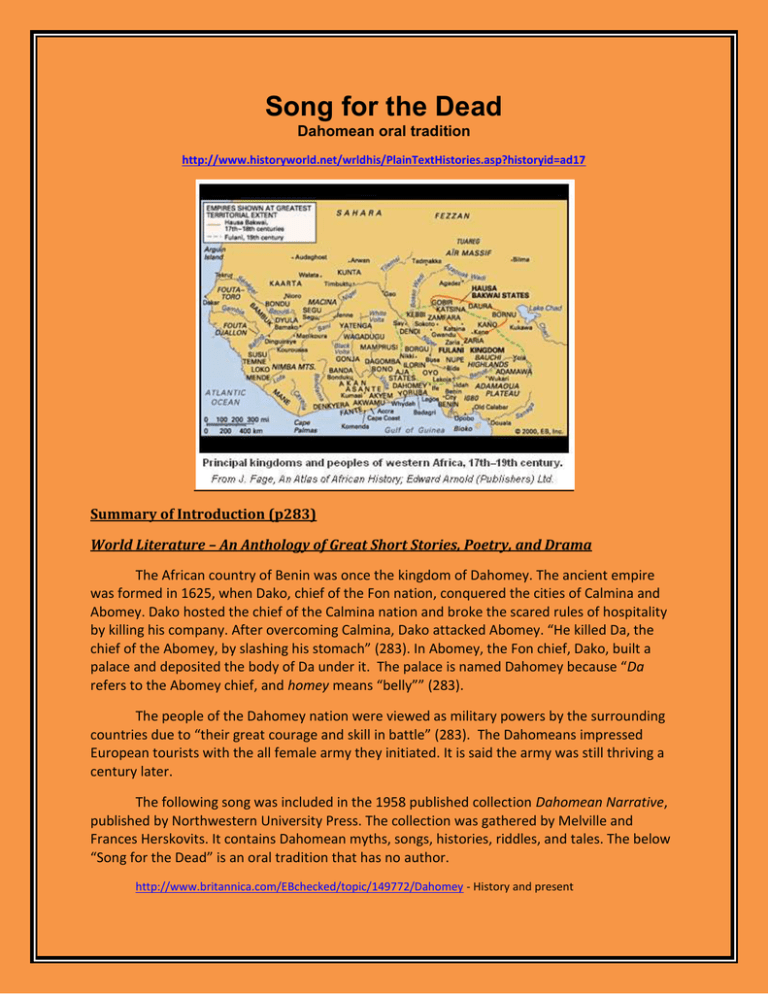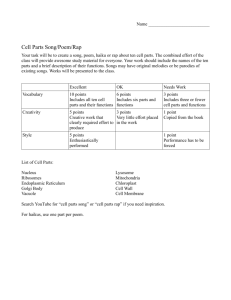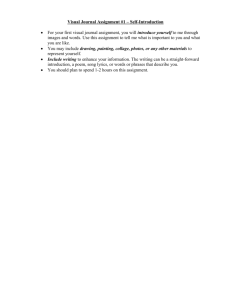Song for the Dead project
advertisement

Song for the Dead Dahomean oral tradition http://www.historyworld.net/wrldhis/PlainTextHistories.asp?historyid=ad17 Summary of Introduction (p283) World Literature – An Anthology of Great Short Stories, Poetry, and Drama The African country of Benin was once the kingdom of Dahomey. The ancient empire was formed in 1625, when Dako, chief of the Fon nation, conquered the cities of Calmina and Abomey. Dako hosted the chief of the Calmina nation and broke the scared rules of hospitality by killing his company. After overcoming Calmina, Dako attacked Abomey. “He killed Da, the chief of the Abomey, by slashing his stomach” (283). In Abomey, the Fon chief, Dako, built a palace and deposited the body of Da under it. The palace is named Dahomey because “Da refers to the Abomey chief, and homey means “belly”” (283). The people of the Dahomey nation were viewed as military powers by the surrounding countries due to “their great courage and skill in battle” (283). The Dahomeans impressed European tourists with the all female army they initiated. It is said the army was still thriving a century later. The following song was included in the 1958 published collection Dahomean Narrative, published by Northwestern University Press. The collection was gathered by Melville and Frances Herskovits. It contains Dahomean myths, songs, histories, riddles, and tales. The below “Song for the Dead” is an oral tradition that has no author. http://www.britannica.com/EBchecked/topic/149772/Dahomey - History and present Song for the Dead I see it, There is no enjoying beyond Death, And I say to all of you say, That which your senses taste of Life Goes with you. I say to you say The wives you have, The passion you know of them Goes with you. I say to you say The drinks you drink, The pleasure of them Goes with you. I say to you say The meats you eat, The relish you have of them Goes with you. I say to you say The pipes you smoke, The quiet they bring Goes with you. Come, then Dance all the colors of Life For a lover of pleasure Now dead. Understanding the poem 1. Why do the Dahomeans dance for the dead? The Dahomeans dance to honor the dead. 2. What attitude toward life or what theme does the song express? The theme expresses death as taking away the pleasures of life. Analyzing Lit Technique 1. What is appropriate about the metaphor “all the colors of Life”? Colors are bright or dark, contrasting or comparative, just as life is. 2. What is the effect of repetition in the song? The repetition creates unity in the poem and also creates an allusion. 3. Why are the stanzas arranged in this order? Stanzas create division of thoughts in the poem and bring it to a conclusion. Writing about the Literature 1. Analyze the organization of the poem. In what way is the poem’s structure like the structure of an expository essay? In an expository essay, the writer shows and supports their view. This poem shows the Dahomeans’ view on life. 2. Write an essay or poem that expresses the Dahomean philosophy of life or another philosophy of life. Make sure that you state your central idea and provide supporting details. What metaphors or images are appropriate to the philosophy you wish to express? The Dahomeans’ philosophy of life states “There is no enjoying beyond Death,” and “your senses taste of Life Goes with you.” The Dahomeans believed that an individual should enjoy the pleasures of life while he or she is alive because when he or she passes, they cannot be enjoyed any longer. The poem has no author as it is part of the Dahomeans’ tradition, but stresses that every emotion, feeling, and enjoyment is no longer available when a person dies. The ending stanza urges everyone to come and “dance all the colors of Life” to honor and celebrate the death. Related Unknown South Dakota Literacy Devices Found In The Poem Connotation The attitudes and feelings associated with a word. These associations can be negative or positive, and have an important influence on style and meaning. The song uses words like “pleasure,” “passion,” and “relish.” These words express feelings of happiness, delight, zeal, enthusiasm, and excitement for various actions in life. The song says once one is dead, one is unable to enjoy life anymore. Assonance The repetition of vowel sounds in non-rhyming words (ship in distress) Non-rhyming vowel sounds are not used in the song. Denotation The literal or dictionary definition of a word. The song contains simple words like “pleasure,” “passion,” and “enjoy” that make it unnecessary to look for the denotation. Consonance The repetition of consonant sounds within and at the ends of words (e.g. It is blunt and flat.) Often used with assonance, alliteration, and rhyme to create a musical quality, to emphasize certain words, or to unify a poem. The repetition of “goes with you” gives the song its musical quality although the words do not use repeating consonant sounds. South Dakota 12th Grade Reading Standards Fulfilled 12th Grade 12.R.1.1 (Synthesis) Students can interpret the meaning of unfamiliar words using context clues to extend vocabulary. In stanza 4, “relish” was an unfamiliar word. By using the previous stanzas as examples for the emotion and feeling from certain objects, I found the meaning for “relish.” 12th Grade 12. R.2.1 (Evaluation) Students can evaluate how style affects the meaning of text. The song has a simple style that creates a simple theme such as saying, “there is no enjoying beyond death.” 12th Grade 12.R.3.1 (Analysis) Students can analyze text for the authors’ style. This oral tradition uses repetition and imagery to create style using the phases “goes with you” and “dance all the colors of life.” 12th Grade 12.R.4.1. (Evaluation) Students can evaluate the depiction of human experience in literary works from diverse cultures, locations, and time periods. The Dahomean song was used to honor and celebrate the dead. “… the poem, recognizing that all people share an inevitable mortality, expresses the importance of enjoying life.”








